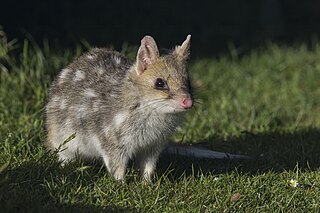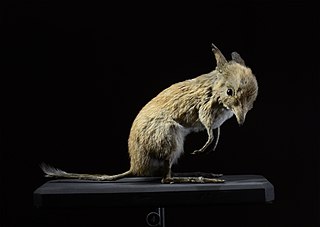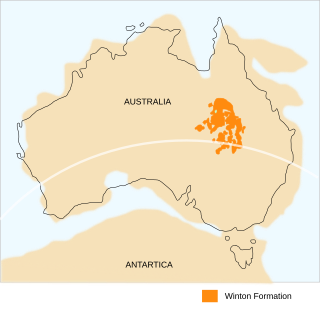
The Phascolarctidae is a family of marsupials of the order Diprotodontia, consisting of only one extant species, the koala, and six well-known fossil species, with another five less well known fossil species, and two fossil species of the genus Koobor, whose taxonomy is debatable but are placed in this group. The closest relatives of the Phascolarctidae are the wombats, which comprise the family Vombatidae.

Megalania is an extinct species of giant monitor lizard, part of the megafaunal assemblage that inhabited Australia during the Pleistocene. It is the largest terrestrial lizard known to have existed, reaching an estimated length of 3.5 to 7 metres, and weighing between 97–1,940 kg (214–4,277 lb), but the fragmentary nature of known remains make estimates highly uncertain.

Quolls are carnivorous marsupials native to Australia and New Guinea. They are primarily nocturnal and spend most of the day in a den. Of the six species of quoll, four are found in Australia and two in New Guinea. Another two species are known from fossil remains in Pliocene and Pleistocene deposits in Queensland. Genetic evidence indicates that quolls evolved around 15 million years ago in the Miocene, and that the ancestors of the six species had all diverged by around four million years ago. The six species vary in weight and size, from 300 g (11 oz) to 7 kg (15 lb). They have brown or black fur and pink noses. They are largely solitary, but come together for a few social interactions such as mating which occurs during the winter season. A female gives birth to up to 30 pups, but the number that can be raised to adulthood is limited by the number of teats (6–7). They have a life span of 1–5 years.

Phascolarctos is a genus of marsupials with one extant species, the koala Phascolarctos cinereus, an iconic animal of Australia. Several extinct species of the genus are known from fossil material, these were also large tree dwellers that browsed on Eucalyptus leaves.

The term Australian megafauna refers to the megafauna in Australia during the Pleistocene Epoch. Most of these species became extinct during the latter half of the Pleistocene, and the roles of human and climatic factors in their extinction are contested.

Chaeropus, known as the pig-footed bandicoots, is a genus of small marsupials that became extinct during the 20th century. They were the only members of the family Chaeropodidae in order Peramelemorphia, with unusually thin legs, yet were able to move rapidly. Two recognised species inhabited dense vegetation on the arid and semiarid plains of Australia. The genus' distribution range was later reduced to an inland desert region, where it was last recorded in the 1950s; it is now presumed extinct.

Perameles is a genus of marsupials of the order Peramelemorphia. They are referred to as long-nosed bandicoots or barred bandicoots.

Austrosaurus was an extinct genus of titanosaurian sauropod dinosaur from the Allaru Formation, from the early Cretaceous of Central-Western Queensland in Australia.

Macropus is a marsupial genus in the family Macropodidae. It has two extant species of large terrestrial kangaroos. The term is derived from the Ancient Greek μάκρος, makros "long" and πους, pous "foot". Thirteen known extinct species are recognised. The type species is the eastern grey kangaroo.
Scott Hocknull is a vertebrate palaeontologist and Senior Curator in Geology at the Queensland Museum in Brisbane. He was the 2002 recipient of the Young Australian of the Year Award.

Quinkana is an extinct genus of mekosuchine crocodylians that lived in Australia from about 28 million to about 10,000 years ago. Most attributed specimens have been found in Queensland. It is speculated to have been one of the top predators of Pleistocene Australia.

Palorchestes is an extinct genus of large terrestrial, herbivorous Australian marsupial of the family Palorchestidae, living from the Miocene through to the Late Pleistocene. Like other palorchestids, it had highly retracted nasal region suggesting that it had a prehensile lip, as well as highly unusual clawed forelimbs that were used to grasp vegetation.

Phascolonus is an extinct genus of giant wombat known from the Pliocene and Pleistocene of Australia. There is only a single known species, Phascolonus gigas, the largest wombat ever known to have existed, estimated to weigh as much as 200 kg or 360 kg (790 lb). It was described by Richard Owen in 1859. Phascolomys magnus is a probable junior synonym. P. gigas is distinguished from other wombats by its strap-shaped upper incisors. The cranial roof is noticeably inwardly depressed. The species was abundant across Australia, with remains having been found in all states except Western Australia. It is suggested to have had a preference for arid and semi-arid inland habitats, with a diet consisting of a high amount of low quality vegetation. Though it likely had wide home-ranges, it probably did not stray far from fresh water sources. Abundant remains have been found in Pleistocene aged deposits from Lake Callabonna in South Australia. Unlike its living relatives, it is unlikely that Phascolonus engaged in burrowing. Phascolonus disappeared during the Late Pleistocene Quaternary extinction event around 50-40,000 years ago, together with many other large Australian animals, following the arrival of humans to the Australian continent. Phylogenetic analysis suggests that is closely related to the other giant wombat genera Ramsayia and Sedophascolomys.

The Winton Formation is a Cretaceous geological formation in central-western Queensland, Australia. It is late Albian to early Turonian in age. The formation blankets large areas of central-western Queensland. It consists of sedimentary rocks such as sandstone, siltstone and claystone. The sediments that make up these rocks represent the remnants of the river plains that filled the basin left by the Eromanga Sea - an inland sea that covered large parts of Queensland and central Australia at least four times during the Early Cretaceous. Great meandering rivers, forest pools and swamps, creeks, lakes and coastal estuaries all left behind different types of sediment.
Warendja is an extinct genus of wombat. It is known from two species, W. encorensis from the Late Miocene Riversleigh site in Queensland, and W. wakefieldi known from the Pleistocene of South Australia, New South Wales, and Victoria. The two species are primarily distinguished by features of their enamel. It became extinct as part of the Quaternary extinction event. Warendja wakefieldi is estimated to have weighed about 10 kg, considerably smaller than living wombats. Warendja thought to be relatively basal amongst wombats, being the most primitive member to possess hypselodont cheek teeth. The morphology of the humerus of W. wakefieldi suggests that it engaged in scratch-digging.
Ramsayia is an extinct genus of giant wombat, weighing around 100 kg. Ramsayia is known from two species, Ramsayia lemleyi from the Pliocene of Queensland, and Ramsayia magna from the Pliocene to Late Pleistocene of Queensland and New South Wales. The skull superficially resembles that of the giant beavers Castoroides and Trogontherium. The large premaxillary spine suggests it possessed a large fleshy nose. The shape of the skull of R. magna suggests that it did not engage in burrowing. Cladistic analysis suggests that it is closely related to the other giant wombat genera Phascolonus and Sedophascolomys. Like other giant wombats, its size is thought to have been adaption to feeding on large amounts of low quality vegetation. The only certain date of Ramsayia magna dates to the early Late Pleistocene, around 80,000 years ago, making the timing of its extinction uncertain.

Wintonotitan is a genus of titanosauriform dinosaur from Cenomanian -age Winton Formation of Australia. It is known from partial postcranial remains.
The Capricorn rabbit rat is an extinct species of rodent from Queensland, Australia. It was described as a new species in 2010 on the basis of Pleistocene and Holocene dental remains. The specific name refers to the Capricorn Caves in Queensland, one of the locations where remains were unearthed. Some of the subfossil material post-dates the European settlement of Australia, so the Capricorn rabbit rat is a modern extinction. Since there has not been a targeted survey for the Capricorn rabbit rat, there is a thin hope of its survival, although this is unlikely.

Australotitan is an extinct genus of titanosaurian sauropod that existed during the Cenomanian-Turonian age of the Late Cretaceous in what is now southern-central Queensland, Australia. The genus contains a single species, Australotitan cooperensis.
Sedophascolomys is an extinct genus of wombat known from the Pliocene and Pleistocene of Australia. There is a single recognised species, S. medius, which was formerly placed in the invalid genus Phascolomys. It was found in the northeastern and eastern regions of the continent. It is estimated to be somewhat larger than extant wombats, with a body mass of 70-75 kilograms. The youngest remains of the genus date to the Late Pleistocene, around 50-40,000 years ago. It is thought to be closely related to the giant wombat genera Phascolonus and Ramsayia.















